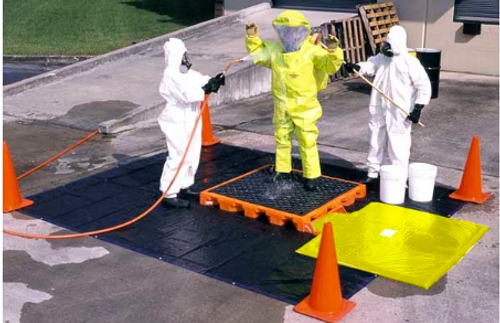How To Safely Remove Contaminated PPE Clothing
In order to get out of your protective clothing without subjecting yourself to the materials you've been so careful to avoid, field decontamination procedures should be followed carefully. This process does not make the garment safe for re-use. Rather it is a way to extricate yourself from the clothing that has protected you before it is discarded.
DuPont's protective Tychem garments, like their more common Tyvek hazmat coveralls are designed for limited-use applications. Even the heavy-duty Level A EX Commander Suit is supposed to be discarded after exposure to high-level biological contaminants like Ebola or poisonous gases like Sarin. It's up to the user of the garment to determine if the suit has been contaminated or can be safely reused.
To doff (or take off) clothing that has been used in a hazardous area, follow these steps for Field Decontamination:
1. Leave the contaminated area (or hot zone). If an SCBA unit is being used, make sure there is sufficient air remaining for the time it will take to complete field decontamination and garment removal.
2. Continue using the respirator through this entire process. Step into a liquid containment area. If you're setting up your own station a simple, inflatable kiddie pool can be used to contain the rinse and wash liquids.
3. Before taking anything off have a helper who is knowledgeable about doffing procedures use water and mild dish washing liquid or a liquid biological disinfectant such as active peroxide or household bleach diluted at a 1:9 ratio (10% bleach to water) to clean the garment. Disinfectant can be sprayed on with a simple pressure pump. The helper must be wearing waterproof gloves, liquid splash protective goggles, protective clothing, and respiratory protection. Excess rinse water must be removed from the suit by the helper. Pay close attention to all rinse water near the garment closure and make sure it is fully absorbed and dry before opening.
If using the activated peroxide or bleach mixture, be sure to give it sufficient time to work before wiping it off or opening the closure. A quick note about disinfectant shelf life - remember that bleach can expire. It has a listed shelf life of six months and is less stable once it is diluted. Typically bleach will lose 20% of it's disinfectant properties each year. ( Scripps.edu)
3. Once the garment has been opened completely by the helper, they will help extricate the wearer by carefully peeling the suit away so that none of the outside of the garment touches the person. Starting with the head and shoulders, the suit should be carefully turned inside out and peeled down until the wearer can sit down and have the boots removed. Without touching the outside of the garment, the rest of the suit is taken off.
4. Finally the respirator and goggles can be removed. Take special care when removing these pieces to assure the area around the face seal is disinfected and dried before these final pieces of ppe are removed. If SCBA is being used, the harness and tanks can now be removed.
It's a complicated process and not something anyone should take lightly. Proper doffing procedures must be practiced by a well-trained team if they hope to systematically eliminate the risk of contamination after the worst exposure has taken place. If you have questions about these procedures you can read the DuPont Tychem User Manual and we are available to take your calls Monday through Friday 6am till 5pm PST at 1-800-829-9580.
Recent Posts
-
Promoting Safety: National Work Zone Awareness Week is April 15-19, 2024
Each year, the National Work Zone Awareness Week (NWZAW) places the spotlight on the importance o …Apr 11th 2024 -
Understanding 4 Gas Monitors: How They Work & Why They Are Important
In today’s increasingly dynamic industrial landscape, 4 gas monitors have emerged as critical com …Apr 8th 2024 -
April Showers Require Workers to Wear Hi-Vis Safety Rain Gear
While April showers bring May flowers, they also bring challenges, particularly for those working …Apr 1st 2024





